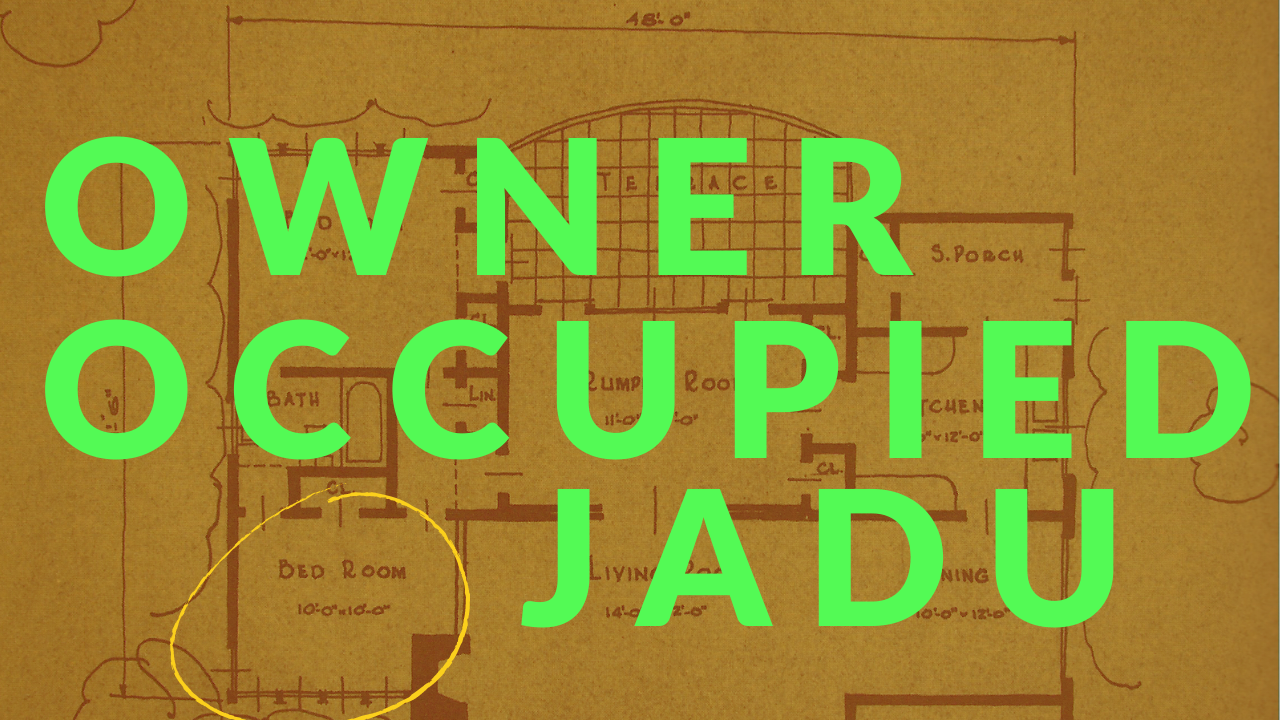Owner Occupancy Requirements with Junior Accessory Dwelling Units (JADUs)
Junior Accessory Dwelling Units are a great tool for homeowners who are trying to convert part of their residence into an independent dwelling unit.
But…
Junior Accessory Dwelling Units have some significant limitations, one of which is an owner occupancy requirement.
This is a pretty wonky post about a specific legal requirement of JADUs. Here are links to a broader definition of Junior Accessory Dwelling Units, and a definition of conventional Accessory Dwelling Units.
The legal definition of Junior ADU owner occupancy requirements
According to the California government code as of January 1, 2020, Junior Accessory Dwelling Units have an owner occupancy requirement for the residence in which the JADU will be permitted.
Here’s the relevant section of the government code:
(a) The ordinance may require a permit to be obtained for the creation of a junior accessory dwelling unit, and shall do all of the following:
(1) Limit the number of junior accessory dwelling units to one per residential lot zoned for single-family residences with a single-family residence built, or proposed to be built, on the lot.
(2) Require owner-occupancy in the single-family residence in which the junior accessory dwelling unit will be permitted. The owner may reside in either the remaining portion of the structure or the newly created junior accessory dwelling unit. Owner-occupancy shall not be required if the owner is another governmental agency, land trust, or housing organization.
This means the city or county may require that the homeowner live in the residence with the JADU.
Weird legal scenarios with Junior Accessory Dwellings
What if I want to move out of my house with a JADU in it?
Let’s assume you build a Junior Accessory Dwelling Unit and you get a final inspection and approval over the summer and start renting it out.
If you decided to move, the law requires you to stop renting out the JADU since the residence is no longer owner-occupied.
If you’re renting month to month, that shouldn’t be a big deal because you could give your tenant notice and wait 90 days before officially moving out of the residence.
On the other hand, if you were renting it out on a 1 year lease, you may have locked yourself into living in the residence for a whole year.
My understanding is that you would not technically be able to move out of your house permanently in that time. I’m not sure what the enforcement mechanism would be other than the tenant potentially reporting you or filing a suit.
I wonder if the city or county would make exceptions for well-intentioned homeowners who had to move for work, deployment, health reasons, and so on…
What if I want to sell my house with a JADU in it?
Let’s assume you get a permit for a Junior ADU this year, you build your JADU and get it inspected and approved. Five years from now, you decide to sell your house. What happens?
It’s my understanding that the room is still permitted to be a Junior ADU and it can be rented out as long as the new owner of the house moves into the residence that the JADU is contained within (or moves into the ADU).
What if I build my Junior ADU inside a proposed detached ADU?
Eagle-eyed code readers will know that you can put a Junior ADU inside a proposed detached ADU construction.
(B) One detached, new construction, accessory dwelling unit that does not exceed four-foot side and rear yard setbacks for a lot with a proposed or existing single-family dwelling. The accessory dwelling unit may be combined with a junior accessory dwelling unit described in subparagraph (A)
The way the government code reads, the owner has to live in the single-family residence in which the JADU is permitted.
It’s open to interpretation by the city or county whether that means you have to live in any residence on the SFR-zoned property or if you have to live specifically in the primary residence.
Do all ADUs have owner occupancy requirements?
No, as of January 2020, conventional Accessory Dwelling Units have no owner occupancy requirement.
The requirement is unique to Junior Accessory Dwelling Units.
(6) This subdivision establishes the maximum standards that local agencies shall use to evaluate a proposed accessory dwelling unit on a lot that includes a proposed or existing single-family dwelling. No additional standards, other than those provided in this subdivision, shall be used or imposed, including any owner-occupant requirement, except that a local agency may require that the property be used for rentals of terms longer than 30 days.
Why build a JADU if it has this requirement?
There are a few situations where JADUs are extremely useful to homeowners. Here are some examples:
You want to bring a non-conforming remodel up to code
You want to convert non-living space like a garage or basement into livable square footage
You're building a detached ADU and you want to make it a duplex to get more rental income
Read more about the pros and cons of Junior Accessory Dwelling Units.

